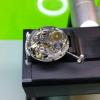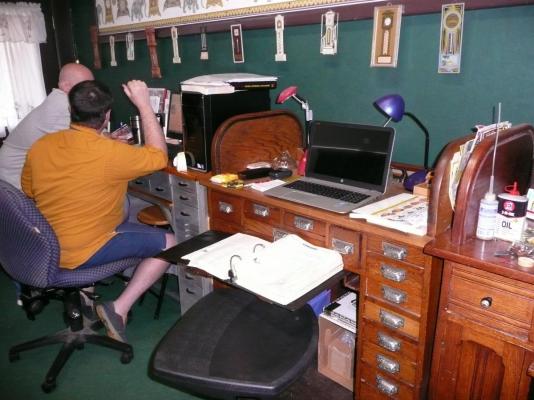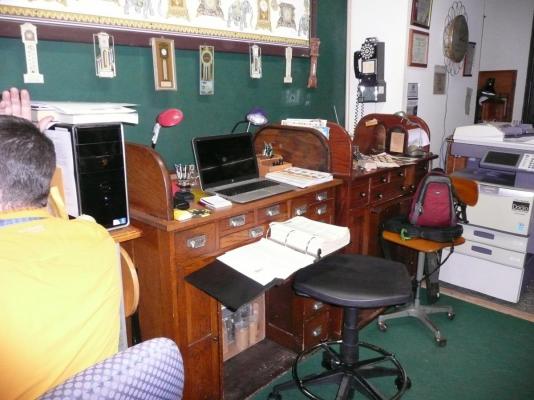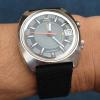Leaderboard
Popular Content
Showing content with the highest reputation on 09/09/15 in all areas
-
This is the first installment of what I hope will be a series of updates on my experience at the York Time Institute. In Lesson 1 of the Chicago School of Watchmaking's Master Watchmaking Shop Training and Job Guides, Thomas B. Sweazey says, The second sentence of this quote spells out the ethos of the York Time Institute as expressed by its director Daniel Neid. "Dan" is firmly committed to the idea that his students will not only be able to make repairs from stock parts but also, if necessary, be able to make parts when necessary. Not only that he will also be able to understand all the different mechanisms that go to make up the complete watch--including but not restricted to casemaking. My experience so far is that Mr. Neid not only has the knowledge but the tools to put paid to this claim--we shall see. I hope to be able to provide vignettes of how much I will be able to learn and put to practice. For now I am totally amazed--one might say overwhelmed--by not only Dans knowledge of current practices but his avid knowledge of the history of the techniques and tool of this honorable and difficult craft. He has an absolutely amazing array of tools, many of them very rare and practically unattainable. I spent the better part of yesterday afternoon inspecting a multitude of watchmakers lathes; ranging from small bow-driven lathes to modern motor driven ones. Add in a huge number of examples of all the tools mentioned in the Chicago School's manual. He not only has examples of modern tools but their predecessors that date back well into the 19th century. I am looking forward to the chance to try them--especially the bow and treadle-driven lathes. We spent several hours today examining measuring devices, many of them factory pieces once used at places like Hamilton, Waltham and Bulova factories. It is amazing how many kinds of devices have been developed to perform the many types of measurements required for watchmaking. Again, I was overwhelmed and am looking forward to trying some of them. Dan has a good rationale for spending a good amount of time inspecting the tools of the trade: he says it will be invaluable for being able to identify tools at various kinds of sales such as estate sales, yard sales (yes many of his tools have come from such sources). The student (like me) will be able to sometimes get great bargains by being to identify a tool that perhaps its owner doesn't recognize. The other students confirm that they have, in fact, put their knowledge to acquiring lots of interesting pieces themselves. We work in close quarters in a shop chock-a-block full of watchmaking tools and a huge inventory of parts. I once spent some time at sea on a nuclear submarine every facet of which serves some importance towards its mission. It was like living inside a machine. I get this same feeling at the institute. The close quarters serves to create an espirit de corps that I hope I will be able to share someday. The students are inculcate with sense of being a "breed apart" from the ordinary person and take pride in their work. It's also informal but serious and sometimes not so serious. Dan seems to be a good psychologist recognizing emotional ups and downs that can accompany success and defeat. The former receives praise but a gentle reminder to keep focused and not to let them swell the head. The latter is met with the reassurance that our foulups and fumbles are a necessary part of the learning experience; the even experienced students and masters loose parts and break things--underscoring the need to be able to make what one does not have or has lost or destoryed. When we get into a dudgeon over repeated failures Dan says, "Go take a break and don't let it get under your skin." Because it is through failures and even catastrophes that one really learns. One must develop patience and take the time to get the task right. He pays attention to how our tools are organized by task and frequency of use. He helps his students acquire their tools from the least expensive sources--though considerable expanses will be incurred event the. Though students are encouraged try out his many tools and devices to further direct acquisitions by the student. I just bought a nice lathe with complete sets collets. I will spend some of my time restoring it to mint condition. And its not jjust Dan, the other students are willing pitch in by selling the beginner some ot their surplus tool at very reasonable prices. I too donated to the Institute several of my supplies to the general pool can be of help to all students. We are constantly being giving spot tests to see what we've learned. For now my tests are ones of recognition. I'm getting tired to I'll cut this short by showing you a couple pictures of my bench. It's an old bench as you can see with a place for a treadle on the left. I love the feeling that I am working where generations of watchmakers worked before me. My I do them honor and justice. My bench is the one in the middle with my laptop on it. Today they are indispensable for research.1 point
-
Okayyy......... From what I can see....... Top row left to right: 1. not sure. 2. bezel insert spacer. 3. 7S26-0050 case. 4. unknown crown & stem (might be for the 7s26). Mid row: 1. 4205 dial. 2. unknown grey movement spacer. 3. bezel insert. 4. bezel complete. 5. 4205 case. 6. caseback. Bottom row: 1. pepsi bezel insert. 2. 4205 movement spacer. 3. unknown black movement spacer. 4. not sure. 5. 4205 case 6.4205 caseback. 7. bezel with spacer & without insert. Cant be 100% sure but if you can post closer individual pics of the items I would be able to confirm what is what. You should be able to make up one 4205 from this lot with the addition of a caseback gasket, probably a bezel o-ring, movement, hands, chapter ring. crown and stem. Same extras again plus another movement spacer will give you 2, although it looks like the case on the bottom row is missing its crystal and gasket. Crystals are not a problem, however the gasket is another matter. As for the 7s26 it looks like it could do with a movement, movement spacer, dial, hands, chapter ring etc. Bezel inserts if properly made will snap fit, if not they can be glued in place. Bezels on Seikos are retained by a silicone greased o-ring that sits in an inner grove on the bezel just below the bezel inset & spacer. These are snapped on to the case using a suitable press but can sometimes be put in place by finger & thumb pressure alone. They are bi-directional with the click being supplied by tiny ball bearing on top of a spring pressed into the case under the bezel.1 point
-
Last few rays on the balcony & then a bucket of last night 2 for 1 cocktails. Sent from my GT-I9505 using Tapatalk1 point
-
Also might be useful to place any parts that could be affected by heat in the topmost basket where the heat will be less intense.1 point
-
I had the balance staff on a tack went in with my smallest screwdriver & twisted the collet. As I retrieved my screwdriver I caught one of the coils & bent it. It,s a very small spring & it took an age to get it back to the correct shape. I HATE HAIRSPRINGS :crazysmile:1 point
-
Hi there, Bob, Yes, I am some-what surprised at the lack of response to my request for help. I know that there is a machine that the Jacot tool can be used with, but there just has to be another (Cheaper) way of achieving the same result. Never mind, I will use the 'trial and error' method. Hopefully, the balance staff pinion will not meet the same demise as the one it has replaced! If it does.........not a problem. I will simply pick myself up, dust myself off and say "oh dear!" Len.1 point
-
Hi Len, Five possibilities. 1. Broken jewel...since you've removed the hairspring I assume you would have eliminated this. 2. Too much endshake..ditto above.. 3. Bent pivot.... inspect pivots closely. If bent then you need to change the balance shaft. While some guys have success with bending pivots back into shape your chances of failure are high. 4. Balance wheel not level on staff. You need to remove the roller table, user a stake larger than the riveted portion to get the balance wheel level, then re-stake the balance wheel so that it stays put. You also need to re-poise the wheel as it is possible the wheel has shifted from its original position relative to the staff. 5. Balance wheel arm bent... not common but possible.. again roller table comes off, Balance on staking block, gently massage the arms of the balance wheel to get it back in shape. Make small changes and check constantly. Watch truing calipers can help identify the problem but don't attempt to fix the wobble with these as it will just break the pivot. Sorry there is no quick fix! Anilv1 point
-
no need for reply now thanks. I have done the job with a small vice and a gentle tap in the right direction. cheers!1 point








